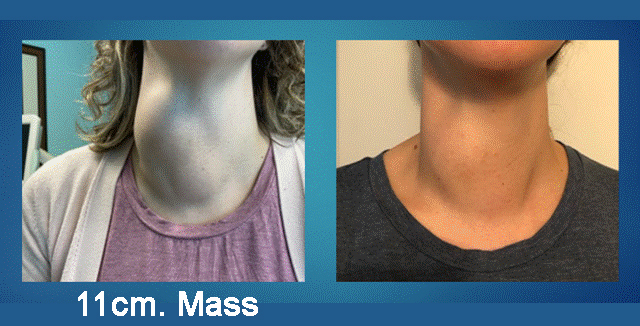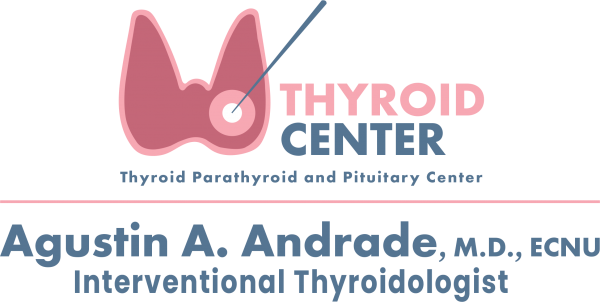Choosing Radio Frequency Ablation in Miami, FL, Over Surgery
The general rule with treatment is to opt for the least invasive method. This is because you’ll heal faster, it costs less, and it is equally as effective. This is why many people who have developed thyroid nodules opt for radio-frequency ablation in Miami, FL, over surgery.
With radio-frequency ablation (RFA), patients undergo an outpatient procedure under local anesthesia. The goal is to reduce the size of non-cancerous nodules that cause discomfort, problems with swallowing, and self-consciousness about appearance.

Results One Month After RFA
The Doctor Performing the Procedure
Our doctor performing radio-frequency ablation is Dr. Agustin A. Andrade, MD, ECNU. He’s known as a pioneer in the field and one of only a handful who provides RFA treatment across the country. Instead of sending the patient to surgery, Dr. Andrade inserts an RF electrode into the nodule. A high-frequency current passes through the RF Electrode into the nodule, sending heat into the tumor to reduce its size.
This FDA-approved procedure in Miami is non-invasive and quick, causing little pain, and leaves the patient free to go home after about a half-hour of observation. And the cost is much less than the price for surgery.
Before selecting your Physician for treatment, make sure you know how many procedures the doctor has performed and years of experience in RFA.
A patient is given a local anesthetic (meaning the patient is awake without pain). Then, our doctor inserts a thin needle into the nodule through the skin. A high-frequency current passes through the tip of the needle, which heats the tumor and destroys the thyroid nodule.
This is very unlikely. RFA causes less than 1.0% chance of hypothyroidism. In conventional surgery, the risk of hypothyroidism goes from a 50% chance if half of the thyroid is removed to 100% if the whole thyroid is removed.
This is a case where the numbers speak for themselves.
Hematoma 1%
Voice Change 1%
Skin Burn 0.22%
Tumor Rupture 0.1%
Abscess 0.07%
Hypothyroidism 0.07%
Since RFA was approved by the Food and Drug Administration (FDA) in 2018, no university or teaching facility has or is training doctors on this procedure. Therefore, the great majority of physicians in the United States have not been exposed to, or are not yet aware of its existence, as opposed to Europe or Korea where RFA has been vastly known for the past 20 years.
The time of the procedure could vary between 30 to 45 minutes, depending on the size of the nodule.
This non-surgical procedure is only for patients with benign nodules that have:
- Symptoms, Such as Dysphagia (Difficulty Swallowing Food or Liquids), Foreign Body Sensation, Discomfort, or Cough
- Cosmetic Problems
- A Hyperfunction Thyroid Nodule
Clinical trials in Italy and South Korea have demonstrated 50% to 80% durable nodule shrinkage after RFA.
If you have a hyperfunctional nodule in the thyroid, the best treatment for you is RFA.
The patient will be in observation for 20 to 40 minutes after treatment.
The patient will feel a pressure or burning sensation in the neck, jaw, or chest that will last for a few hours.
Looking at the two side by side, there are considerable differences between both:
RFA
- Local Anesthesia
- 1% Risk of Recurrent Never Damage (Voice Change)
- No Scarring
- Outpatient Procedure
- Minimal Pain Afterward
- Cost in the United States -- $6,000 to $8,000
Surgery
- General Anesthesia
- Recurrent Nerve Damage Risk: 7% to 14% (Voice Change)
- Scarring
- Hospital Stay of 1 to 3 Days
- Pain After Surgery
- Cost in the United States $14,000 to $20,000
Call our practice to talk with our doctor about RFA to treat thyroid tumors.
